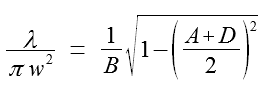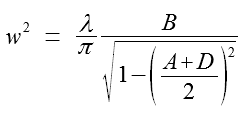Calculation of Beam Parameters in Resonators
The description is given according to the book “Lasers” by A.E. Siegman, see chapter 21 “Generalized paraxial resonator theory”.
For the analysis, we need to select a reference plane to calculate the round trip matrix against. In general, an element chosen as a parameter of a particular function is the reference plane.
Having the round-trip matrix we can write an expression for transformation of complex parameter:
Because we consider a stable resonator, the output parameter is the same as the input one, so the beam is self-consistent, and it reproduces itself after full round-trip through the resonator:
Then we can find out the complex parameter as a solution to the quadratic equation:
But for convenience, it is better to rewrite this equation meaning the inverted complex parameter:
using the relationship
Self-conformed Complex Radius of Curvature
The solution to this equation gives values of the complex parameter of self-consistent Hermite-gaussian mode in the resonator:
or
One of the solutions gives unreal situation when the beam’s energy increases with radial distance.
Knowing the expression of the complex parameter through beam characteristics
we can express the properties of the self-consistent beam in terms of round-trip matrix elements.
Radius of Wavefront Curvature
Calculation of the radius of wavefront curvature of the self-consistent beam from components of round-trip matrix:
Beam Radius
Calculation of the self-consistent beam radius from components of round-trip matrix:
See also













